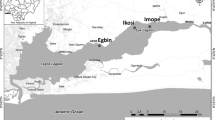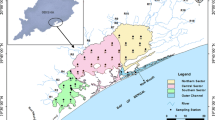Abstract
The spatial and temporal dynamics of physical variables, inorganic nutrients and phytoplankton chlorophyll a were investigated in Xiangxi Bay from 23 Feb. to 28 Apr. every six days, including one daily sampling site and one bidaily sampling site. The concentrations of nutrient variables showed ranges of 0.02–3.20 mg/L for dissolved silicate (Si); 0.06–2.40 mg/L for DIN (NH4N + NO2N + NO3N); 0.03–0.56 mg/L for PO4P and 0.22–193.37 μg/L for chlorophyll a, respectively. The concentration of chlorophyll a and inorganic nutrients were interpolated using GIS techniques. The results indicated that the spring bloom was occurred twice in space during the whole monitoring period (The first one: 26 Feb.–23 Mar.; the second one: 23 Mar.–28 Apr.). The concentration of DIN was always high in the mouth of Xiangxi Bay, and PO4P was high in the upstream of Xiangxi Bay during the whole bloom period. Si seems no obvious difference in space in the beginning of the spring bloom, but showed high heterogeneity in space and time with the development of spring bloom. By comparing the interpolated maps of chlorophyll a and inorganic variables, obvious consumptions of Si and DIN were found when the bloom status was serious. However, no obvious depletion of PO4P was found. Spatial regression analysis could explained most variation of Chl-a except at the begin of the first and second bloom. The result indicated that Si was the factor limiting Chl-a in space before achieved the max area of hypertrophic in the first and second bloom period. When Si was obviously exhausted, DIN became the factor limiting the Chl-a in space.
Daily and bidaily monitoring of Site A and B, representing for high DIN: PO4P ratio and low DIN:PO4P ratio, indicated that the concentration of Si was decreased with times at both site A and B, and the dramatically drop of DIN was found in the end monitoring at site B. Multiple stepwise regression analysis indicated that Si was the most important factor affect the development of spring bloom both at site A and B in time series.
Similar content being viewed by others
References
Anselin, L. 2005. Exloring Spatial Data with GeoDa™: A Workbook, https://geoda.uiuc.edu/pdf/geodaworkbook.pdf, pp. 198–218.
Anselin, L., Syabri, L., & Youngihn, K. (2006). GeoDa: An Introdction to Spatial Data Analysis, Geographical Analysis, 3(8), 5–22.
Bode, A., Gonzalez, N., Rodriguez, C., Varela, M., & Varela, M.M. (2005). Seasonal variability of plankton blooms in the Ria de Ferrol (NW Spain): I. Nutrient concentrations and nitrogen uptake rates. Estuaries Coastal Shelf Science, 63, 269–284.
Brzezinski, M.A., Nelson, D.M., Franck, V.M., & Sigmon, D.E. (2001). Silicon dynamics within an intense open-ocean diatom bloom in the Pacific sector of the Southern Ocean. Deep-Sea Research Part II-Top. Study of Oceanography, 48, 3997–4018.
Elser, J.J., Marzolf, E.R., & Goldman, C.R. (1990). Phosphorus and nitrogen limitation of phytoplankton growth in the freshwaters of North America: a review and critique of experimental enrichment, Canadian Journal of Fisheries Aquatic Sciences, 47, 1468–1477.
Eppley, R.W. (1972). Temperature and phytoplanktin growth in the sea, Fishery Bulletin, 70, 1063–1085.
Goodchild, M.F. (2003). Geographic information science and systems for environmental management. Annual Review on Environmental Resources, 28, 493–519.
Ha, K., Jang, M.H., & Joo, G.J. (2003). Winter Stephanodiscus bloom development in the Nakdong River regulated by an estuary dam and tributaries. Hydrobiologia, 506–509, 221–227.
Hecky, R.E. & Kilham, P. (1988). Nutrient limitation of phytoplankton in freshwater and marine environments: a review of recent evidence on the effects of enrichment. Limnological Oceanography, 33, 796–822.
Hou, G.X., Song, L.R., Liu, J.T., Xiao, B.D., & Liu, Y.D. (2004). Modeling of Cyanobacterial blooms in Hypereutrophic Lake Dianchi, China. Journal of Freshwater Ecology, 19, 623–629.
Huang, X.F., Chen, W.M., & Cai, Q.M. (1999). Survey, Observation and Analysis of Lake Ecology. Standards Press of China, Beijing, pp. 77–79. (in Chinese).
Iriarte, A. & Purdie, D.A. (2004). Factors controlling the timing of major spring bloom events in an UK south coast estuary. Estuaries Coastal Shelf Sciences. 61, 679–690.
Kocum, E., Underwood, G.J.C., & Nedwell, D.B. (2002). Regulation of phytoplankton primary production along a hypernutrified estuary. Marine Ecology-Progress Series, 231, 13–22.
Kuo, J.T., Lung, W.S., Yang, C.P., Liu, W.C., Yang, M.D., & Tang, T.S. (2005). Eutrophication modelling of reservoirs in Taiwan. Environmental Modelling and Software (in press).
Lagus, A., Suomela, J., Weithoff, G., Heikkila, K., & Sipura, J. (2004). Species-specific difference in phytoplankton responses to N and P enrichments and the N:P ratio in the Archipelago Sea, northern Baltic Sea. Journal of Plankton Research, 26, 779–798.
Maidment, D.R. (2002). Arc Hydro: GIS for Water Resources. California: Redlands, ESRI Press.
Martines, I., Pardal, M.A., Lillebo, A.I., Flindt, M.R., & Marques, J.C. (2001). Hydroydnamics as a major factor controlling the occurrence of green macroalgal blooms in a eutrophic esturay: a case study on the influence of precipitation and river management. Estuaries Coastal Shelf Sciences, 52, 165–177.
Moatar, F., Fessant, F., & Poirel, A. (1999). pH modelling by neural networks. Application of control and validation data series in the Middle Loire river. Ecological Modelling, 120, 141–156.
Newton, A., Icely, J.D., Falcao, M., Nobre, A., Nunes, J.P., & Ferreira, J.G.V. (2003). Evaluation of eutrophication in the Ria Formosa coastal lagoon, Portugal. Continental Shelf Research, 23, 1945–1961.
Regulation for Water Environmental Monitoring (1998), Ministry of Water Resources, P.R. China, Beijing (in Chinese).
Paerl, H.W. (1988). Nuisance phytoplankton blooms in coastal esturine inland waters. Limnological Oceanography, 33, 823–847.
Paerl, H.W., Fulton, R.S., Moisander, P.H., & Dyble, J. (2001). Harmful freshwater algal blooms, with an emphasis on cyanobacterial. Scientific World, 1, 76–113.
Schindler, D.W. (1977). Evolution of phosphorus limitation in lakes. Science., 195, 260–262.
Stumm, W., & Morgan, J. (1981). Aquatic Chemistry, Wiley Interscience, New York, pp. 781.
Turner, R.E., Qureshi, N., Rabalais, N.N., Dortch, Q., Justic, D., Shaw, R.F., & Cope, J. (1998). Fluctuating silicate:nitrate ratios and coastal plankton food webs. Procedings National Academy Science U.S.A., pp. 13048–13051.
Wang, X.J., & Liu, R.M. (2005). Spatial analysis and eutrophication assessment for chlorophyll a in Taihu Lake. Environmntal Monitoring Assessment, 101, 167–174.
Wehr, J.D. & Descy, J.P. (1998). Use of phytoplankton in large river management. Journal of Phycology, 34, 741– 749.
Xie, L.Q., Xie, P., Li, S.X., Tang, H.J., & Liu, H. (2003). The low TN:TP ratio, a cause of a result of Microcystis blooms? Water Research, 37, 2073–2080.
Xu, F.L., Tao, S., Dawson, R.W., & Li, B.G. (2001). A GIS-based method of lake eutrophication assessment. Ecological Modelling, 144, 231–244.
Ye, L., Li, D.F., Tang, T., Qu, X.D., & Cai, Q.H. (2003). Spatial distribution of water quality in Xiangxi River, China. Chinese Journal of Applied Ecology, 14, 1959–1962 (in Chinese).
Author information
Authors and Affiliations
Corresponding author
Rights and permissions
About this article
Cite this article
Ye, L., Han, X.Q., Xu, Y.Y. et al. Spatial analysis for spring bloom and nutrient limitation in Xiangxi bay of three Gorges Reservoir. Environ Monit Assess 127, 135–145 (2007). https://doi.org/10.1007/s10661-006-9267-9
Received:
Accepted:
Published:
Issue Date:
DOI: https://doi.org/10.1007/s10661-006-9267-9




